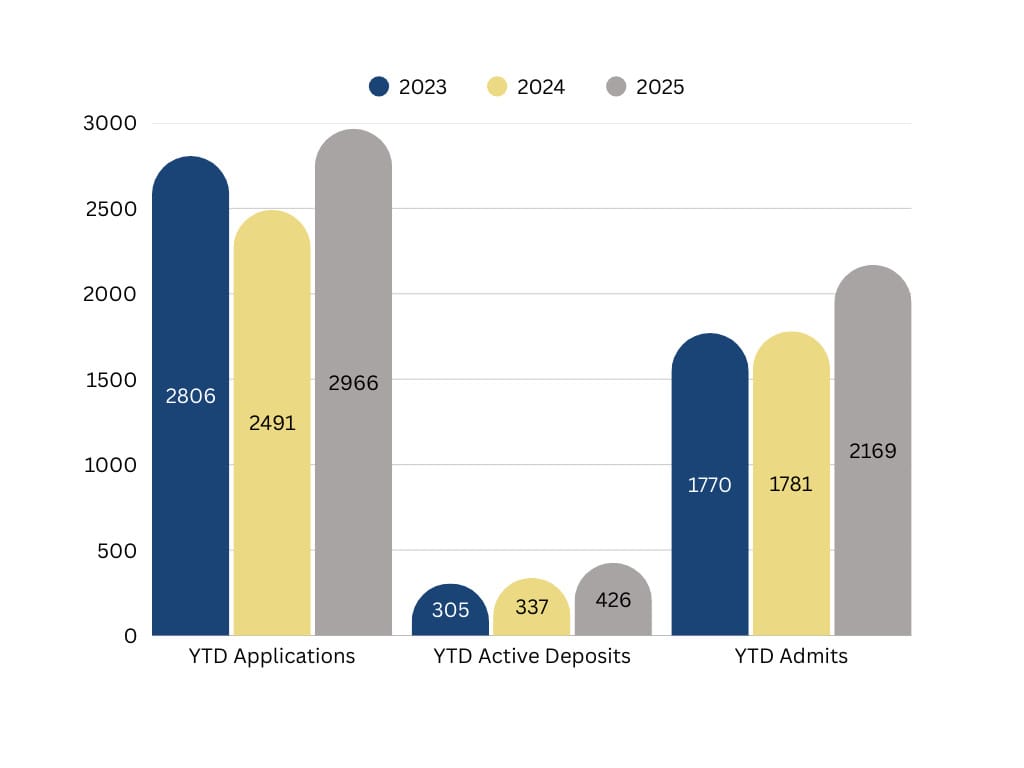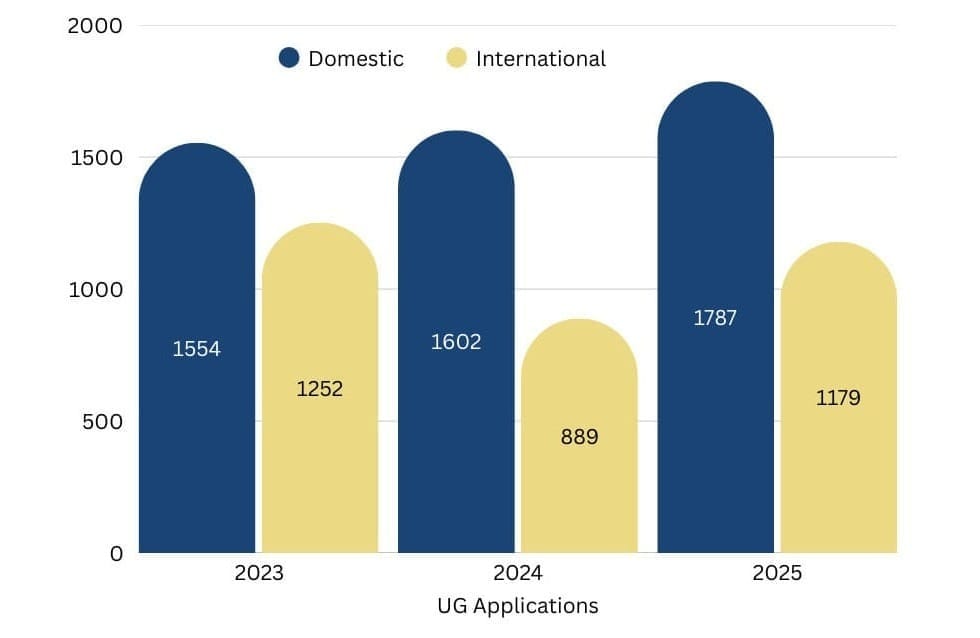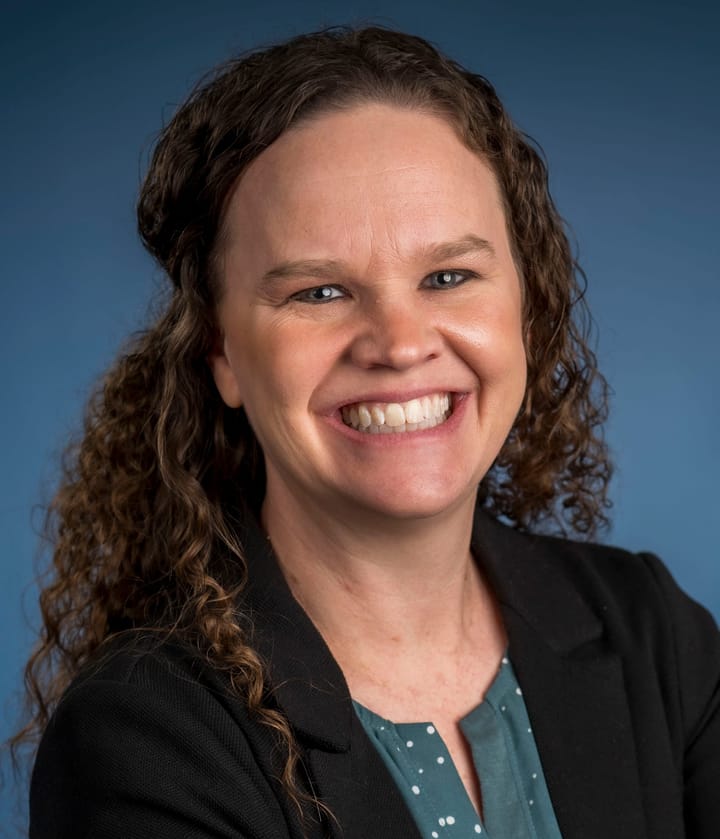Enrollment growth projected for fall 2025

As Augustana prepares for the next academic year, key metrics suggest a large incoming class for fall 2025. Year-to-date (YTD) applications, admitted students and deposits have increased since fall 2024. President Stephanie Herseth Sandlin believes the preliminary data indicates likely enrollment growth, a notable achievement considering the national trend of declining college enrollment.
Although challenges remain, like confirming enrollment of admitted students and bringing international student applications back to their peak after a dip in fall 2024, early signs point to a positive enrollment picture for the coming year.
YTD applications have climbed to nearly 3,000, reflecting a 19% increase from fall 2024. The number of admitted students has also surged by 22%. Perhaps the most encouraging sign is the rise in deposits, which is up 26% compared to last year; this suggests that not only are more students applying and being admitted, but a greater percentage are committing to enroll.
Junior elementary education major Alex Folgar has worked in Admissions for the past 2.5 years and has observed the increase in prospective students firsthand.
“Our admissions counselors are working around the clock in meetings, on the phone or emailing students to make sure their needs are met on top of their other responsibilities,” Folgar said. “It’s no surprise that students are interested in Augie when they feel cared for during a time of big change.”
Herseth Sandlin is encouraged by the trends but acknowledges the significant uncertainties ahead.
“Right now, we’re still optimistic that we can hit our targets, which would be another class over 550, possibly breaching 600,” Herseth Sandlin said. “But we may need to risk-mitigate that in light of the uncertainty we’re navigating [with] these federal regulatory changes.”
Federal policy shifts are creating new obstacles for both domestic and international students. In January, the Congressional Budget Office projected a $2.7 billion shortfall in Pell Grant funding for 2025, which could lead to stricter eligibility criteria or reduced grant amounts if additional funding is not secured. For many students, Pell Grants are an essential source of financial aid, and any reduction in funding could impact their ability to afford college.

In addition, policies are also tightening scrutiny of international student visas. Expanded social media screening allows for visa denials based on a broad definition of “support for terrorism,” impacting F, M and J visas. This crackdown has led to visa revocations and the deportation of students involved in campus protests, especially those related to Palestine.
A potential travel ban affecting over 40 countries could further restrict student visas. The National Science Board reported that, following President Trump’s previous travel ban, the number of international students in the U.S. fell from fall 2016 to fall 2017 by 2.2% at the undergraduate level and 5.5% at the graduate level.
“Every week feels like a month here in terms of changes from a federal regulatory standpoint,” Herseth Sandlin said.
Adding to federal uncertainties is a nationwide “demographic cliff” — a significant reduction in the pool of high school graduates. This demographic shift is primarily driven by lower birth rates following the 2008 financial crisis, as individuals often delay starting families during times of economic uncertainty.
Despite Sioux Falls’ recent population growth, Augustana is not immune to this demographic phenomenon.
Adam Heinitz, associate vice president of enrollment management, explained that Sioux Falls’ growth actually attracts colleges from outside of the immediate region to recruit prospective students.
Heinitz noted that the declining number of high school graduates has led to a “consumer market,” in which colleges must compete more aggressively within a limited pool of students.
In order to make itself stand out, Augustana is working to improve its facilities and campus. Recent and upcoming improvements, such as a new residence hall, apartment complex and renovations to existing buildings, help Augustana feel more modern to prospective students. The addition of competitive club sports like club hockey and club figure skating also help Augustana stand out from other colleges.
While Heinitz highlighted these improvements, he also understands the importance of cost.
“None of that matters if you’re not affordable,” Heinitz said.
To address costs, the university is focusing on increasing scholarship aid. The amount of endowed scholarship money has increased by more than $29 million since the beginning of the Viking Bold initiative in 2020. Other scholarships —like the Buntrock Scholarship, which is the largest donation Augustana has received for impact scholarships — help Augustana’s cost remain competitive with other universities.
While key metrics remain promising, final enrollment numbers remain uncertain until the start of the fall semester.



